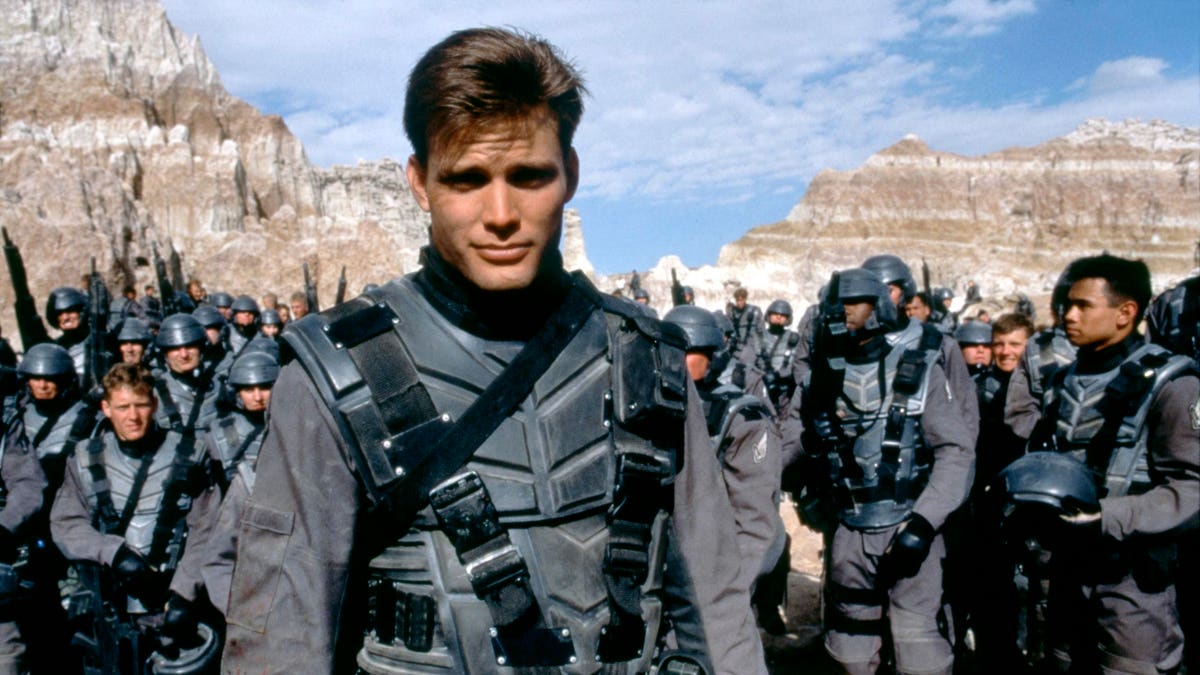“Come on, you apes! You wanna live forever?!”
Malachi Ward is doing his part! The veteran writer/illustrator behind such comics as Black Hammer Reborn and Ancestor recently joined the battle to defeat the insectoid scourge of Klendathu with Varèse Sarabande’s 2-LP vinyl release (now on sale) of the Starship Troopers score composed by the late Basil Poledouris.
“Starship Troopers, Conan the Barbarian, and RoboCop are his trinity of great scores,” Ward tells me over Zoom.
And as “a big Paul Verhoeven fan,” the artist just couldn’t say no when Varèse art director Andy Fischer came knocking with an offer to enlist. “It was a dream job.”
Verhoeven wrote the liner notes for the product, whose artwork you can check out below (be advised that the “Blood & Bug Juice” edition is currently sold out).
An interesting case study in the realm of book-to-screen adaptations, the 1997 film is something of a Trojan horse, cleverly hiding a spoof of runaway jingoism and authoritarianism under an action-heavy shell comprised of an intergalactic war against giant alien bugs.
“It’s his [Verhoeven’s] sharpest satire,” Ward explains. “His sensibility has always incorporated some of the tonal elements of propaganda. And so, in this one, where he is directly satirizing propaganda, he just hits the tonal notes with a surprising amount of depth and nuance that is really rewarding and really incisive.”
The most ironic part of the whole affair is the fact that the Robert A. Heinlein novel upon which Edward Neumeier based the screenplay was written in direct response to the United States attempting to curb nuclear proliferation in the late 1950s. In other words, the source material reflects the rabid militarism Verhoeven sought to skewer.
Rather than shy away from that dissonance, Ward leaned into it with artwork that blends design elements lifted directly from the ‘97 blockbuster with the pulpy aesthetic of the golden age of sci-fi in which Heinlein published his book. The goal, he says, was to pay tribute to classic sci-fi paperbacks of the mid-2oth century, which featured “some of the best illustration work that America has ever produced” and represented a certain naive optimism about space travel, pre-Apollo.
“In the Starship Troopers movie, space … is always rendered in black with white stars,” he adds. “But I knew I wanted to pull in some of those reddish-purples and greens — different tones that are used a lot of time in great pulp drawings.”
The end result is a little more “whimsical,” recalling the eye-popping visuals famously imagined by Hannes Bok, Wally Wood, Virgil Finlay, Alex Schomburg, and others.
“I tried to split the difference between how it is in Starship Troopers, which is sort of over-the-top, anyway,” Ward continues, “and then some of the body language that you’ll see in pulp covers that’s more exaggerated and more theatrical.”
In addition to emulating that retro style, Fischer also wanted the gatefold to look “distressed” and worn out in places as though it were printed on the same cheap paper as those old paperbacks. “There was some trial and error with scanning in actual damage and figuring out different ways to layer that in,” Ward concludes. “But I think it turned out pretty well.”
Would you like to know more? Starship Troopers is currently streaming on Netflix.
Read the full article here





